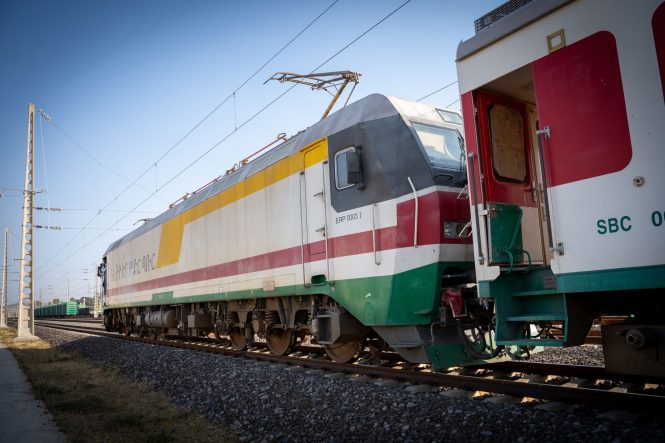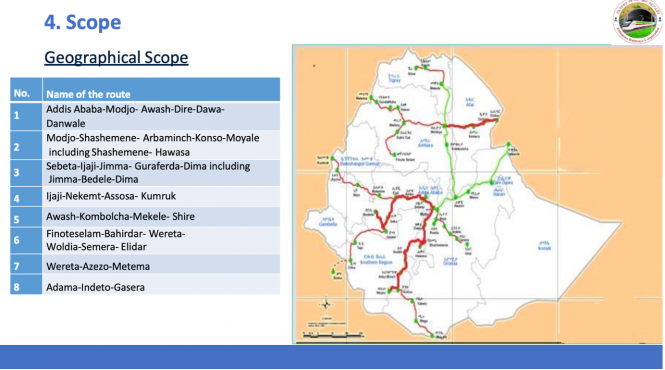Due to emerging industrialisation and the intensification of trade-related activities, road freight transportation has increased rapidly in Ethiopia. Freight transport is expected to increase by more than 13% annually from 2011 to 2030 despite high fuel prices. Demand for passenger transport will also increase by approximately 9% annually, and overall transport emissions are projected to grow 800% from around 5 MtCO2e in 2010 to 40 MtCO2e in 2030.

Photo: Craig Dean
In response to these challenges, the Government of Ethiopia established the Ethiopian Railway Corporation in 2007. The railway projects were submitted as part of Ethiopia’s Nationally Appropriate Mitigation Action (NAMA) submissions to the UNFCCC on a voluntary basis, accompanied by an open request for support. By 2030, it is expected that there will be a railway system with over 5000 km of tracks in operation, which will shift 50% of the business-as-usual growth in road freight transport to rail. This strategic shift is anticipated to significantly reduce greenhouse gas (GHG) emissions while providing numerous economic, social, and environmental benefits.
Electric rail has been identified as the lever with the largest mitigation potential in the sector. By 2030, it is estimated to reduce GHG emissions by 8.9 MtCO2e per year compared to the business-as-usual scenario. Ethiopia has taken on the ambition to capitalise on its rapid economic growth by investing in an economy more resilient to the impacts of climate change and pursuing low-carbon development. The Government of Ethiopia has adopted the Growth and Transformation Plan (GTP), aiming for the country to reach middle-income status before 2025. Concurrently, the Climate-Resilient Green Economy (CRGE) strategy, issued in 2011, outlines the country’s plan to develop a carbon-neutral, green economy by 2025. The provision of an affordable and efficient transport system is crucial to this strategy, contributing significantly to economic growth, employment creation, social welfare, and the expansion of the industrial sector.

The Ethiopian Railways Corporation has actively pursued green climate finance to support these ambitious projects. The Corporation secured three key climate finance sources. Firstly, the Department for International Development (DFID) provided funding to craft the Ethiopian Railways climate finance strategy. Secondly, support for Addis Ababa’s lateral transit-oriented development came from the UNFCCC and technical assistance from the South Korean government. Thirdly, regional climate finance was obtained from the African Development Bank and NEPAD for the Ethiopian-Sudan Railway Bank feasibility studies.
With the population nearing 120 million, the demand for goods and passenger services is escalating, making the expansion of a green, efficient railway network essential.
The 5,000km network aims to connect various regional hubs, with the Djibouti route already completed. The South Sudan extension is in the financing stage for feasibility studies, while the route from Mojo to Moyale to Lamu port is nearing the establishment of a Project Connect Committee (PCC) with the Kenya Railways Corporation in Nairobi, after which the Corporation will proceed to apply for climate finance.
Climate finance is crucial for these projects because railways are significantly greener than other modes of transport. The plan for routes like Ethio-Sudan and Ethio-Djibouti involves full electrification, with power sourced from renewable, clean grids. The goal is to justify climate finance by demonstrating the substantial carbon dioxide reduction.
The overarching strategy is guided by Ethiopia’s Green Transformation Plan (GTP), which includes five pillars: renewable energy, rail transport, agriculture, forestry and building. Rail transport, identified as a key sector for investment under the GTP, is pivotal for securing climate finance. The integration of renewable energy with rail transport can attract significant climate finance, as Ethiopia’s energy largely comes from hydro and wind sources, with increasing investments in solar photovoltaic projects through public-private partnerships (PPP).
In addition to rail, Ethiopia is advancing Green Logistic Ports, such as the 300-hectare facility near Addis Ababa, which will support agro-industrial processing and ease the transfer of goods via rail, further enhancing the climate finance viability. The rapid increase in freight necessitates a shift from road to electric rail transport along eight routes connecting the country’s main economic hubs, such as agriculture, mining, and industrial areas.
This national railway network not only facilitates economic integration but also fosters unity and cultural exchange among the population. The potential for tourism development is significant, and the emission reduction potential has been quantified, setting a model for other African countries to develop their climate strategies.
Countries like India, Brazil, and China have successfully leveraged climate finance by training young, dynamic professionals in environmental and climate finance sectors. Ethiopia plans to adopt a similar strategy, recruiting environmentalists, climatologists, and climate financing experts within the railway sector. This will enable the country to build local expertise, reducing reliance on external consultants and saving hard currency.
Ethiopia’s national strategy includes eight key railway routes, with projects like the Ethio-Djibouti route already completed and others, such as the Lamu project with Kenya Railways, progressing with support from NEPAD and the African Development Bank. The South Sudan connection is also in the pipeline for future feasibility studies.
Technologically, the NAMA will utilise advancements in rail infrastructure, signalling and communication systems, power supply and rolling stock. By meticulously sourcing finance from various channels, including bilateral climate finance and co-financing facilities from countries like Germany, Belgium and the UK, Ethiopia aims to benefit up to 50% of current road freight transport users.
The 5,000 km traffic network is expected to create 30,000 jobs, significantly contributing to local economies. The emission reductions are projected at 9 million tons of carbon dioxide, aligning with Ethiopia’s Earth Climate Finance strategy, which emphasises carbon credits and direct payments for emission reductions. The framework includes seeking support from facilities like the NAMA, GCF, and other bilateral climate finance sources, underscoring Ethiopia’s commitment to a sustainable and green future.
Author :
Publish date : 2024-07-01 06:32:46
Copyright for syndicated content belongs to the linked Source.
—-
Author : africa-news
Publish date : 2024-07-01 13:32:51
Copyright for syndicated content belongs to the linked Source.